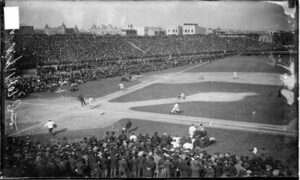Doctor Curmudgeon® The First Five…
By Diane Batshaw Eisman, M.D. FAAP Doctor Eisman is in Family Practice in Aventura, Florida with her partner, Dr. Eugene Eisman, an internist/cardiologist
It was long ago in a faraway land called Chicago.
A warm spring day enveloped the south side and hovered gently over a grammar school.
Through the open windows, birds sang.
The classroom door opened and there was my beloved Uncle Sammy.
After a quiet conference with the teacher, she told me that my equally beloved grandmother Clara, was ill and my uncle was taking me to her.
But I knew by the grin on my uncle’s face, that we were going to the ball game!
As I reminisce about those halcyon days side by side with my uncle, watching a Chicago team play, my thoughts meander to one of baseball’s great and most revered institutions.
It was on February 2, 1936 that the first five were elected into the Baseball Hall of Fame.
The Baseball Writers’ Association of America voted by mail to select the finest players. Out of 226 ballots cast, 170 were needed for election.
And the first five selected were:
Babe Ruth, pitcher and outfielder 215 votes
Christy Mathewson, pitcher.205 votes
Honus Wagner, right fielder.215 votes
Ty Cobb, outfielder and occasional pitcher.222 votes
Walter Johnson, center fielder.189 votes.
But it was not until 1939 that the actual physical Hall of Fame was built in Cooperstown, New York.
Why was Cooperstown selected for this great honor?
After all, it is but a small village in the central part of New York State.
The conception of paying tribute to great players may have had its origin in 1905 when the Mills Commission set forth to determine how the game began. There were those who believed that it had actually come from the English game of rounders.
The Mills committee spent three years researching the game’s origin. It was not until December 30, 1907 (a little before I was born), that their final report was presented stating that ”the first scheme for playing baseball, according to the best evidence obtainable to date, was devised by Abner Doubleday at Cooperstown, N.Y., in 1839.”
Some support for this finding came from a mining engineer, called Abner Graves, who had been a classmate of Doubleday’s In Cooperstown. He claimed that he was present when Doubleday plotted out a field, added bases, and introduced the idea of a pitcher and catcher.
William Guilfoyle writes in the Society for American Baseball Research, “The discovery of an old baseball in a dust-covered attic trunk 27 years later supported the committee’s findings. In a farmhouse in fly Creek, N.Y., three miles from Cooperstown, were found the belongings of the aforementioned Graves and among his possession was a baseball-undersized, misshapen and obviously homemade. The cover had been torn open, revealing stuffing of cloth instead of the wool and cotton yarn which comprise the interior of the modern baseball; but it had a stitched cover. It soon became known as the ‘Doubleday baseball'”.
And then, for the massive sum of five dollars, Stephen C. Clark, a resident of Cooperstown bought that baseball. He placed it on display, along with other baseball objects in a little room in the Village Club.
Clark was one of the heirs to the Singer Sewing Machine fortune. He was a philanthropist and avid art collector. Considered to be the founder of the Hall of Fame, he paid for half of the construction with his own money.
And so on a beautiful day in late Spring, the Baseball Hall of Fame was dedicated in Cooperstown, New York. About twenty thousand people attended on June 12, 1939, more than the population of that quiet village.
As for the Doubleday baseball, there remains much controversy. Theories and speculations continue to abound about the true origin of baseball.
When you say, “Cooperstown,” we who love baseball know that you mean the Hall of Fame.
Cooperstown has become the heart of baseball, its spiritual essence.
The first Five: Ruth, Cobb, Wagner, Mathewson and Johnson.
But to me, they are truly The Fab five.
Dr. Curmudgeon suggests “Bitter Medicine”, Dr. Eugene Eisman’s story of his experiences–from the humorous to the intense—as a young army doctor serving in the Vietnam War.
Bitter Medicine by Eugene H. Eisman, M.D. –on Amazon
Doctor Curmudgeon® is Diane Batshaw Eisman, M.D., a physician-satirist. This column originally appeared on SERMO, the leading global social network for doctors.
SERMO www.sermo.com
Click Here to Order Boxing Interviews Of A Lifetime By “Bad” Brad Berkwitt


